Biology
It is hard to estimate the number of reactions that must take place in a cell every second in order to keep a cell alive and performing its jobs(s)...... but I bet it is more than seven or eight.
How can a factory, or a cell for that matter, keep all the parts for all the different products, all the different workers, and all the different processes and jobs from messing each other up? A factory does this by setting up departments, where individual jobs take place, and then creating management teams that coordinate the work of the different departments?although to often there is too much management and too little production, but that is another matter.
The membranes of organelles look a lot like the membrane that surrounds the cell itself, but organelle membranes are often modified for their particular job. Take the nucleus (Welsh for "kernel of a nut," meaning the central part of a thing) for instance. It has two membranes and nuclear pores that run through both membranes are very specific for what they will let into and out of the nucleus.
The plasma membrane of the cell also limits the passage of molecules, but the nuclear pores are a complex of many unique proteins and this structure that is nowhere to be seen on the cell?s plasma membrane. Just like the membrane of the cell separates what is in the cell from what is outside the cell, the membrane of the organelle separates the needed components of their reactions from all the unneeded components of the cell.
Likewise, the outer membrane of the cell has many jobs that require messages to be transferred from one side of the membrane to the other. Called second messenger systems, these reactions are mechanisms to bring messages from outside the cell to the inside of the cell without the need for anything to cross the cell?s boundary.
Organelles increase specificity, both for individual reactions and for cellular activity as a whole. Many cells in multicellular organisms are specialized for a certain function, and their organelles help them carry out this function. For instance, muscle cells are specialized for contraction, and this requires lots of energy. Therefore, they need many mitochondria, but few other types of organelles. These cells might contain 10-100 times more mitochondria than other cell types.
As we have seen in every topic we have investigated, there are exceptions in the world of organelles. Some organelles are not membrane bound bags that carry things around or house certain reactions. Ribosomes are cellular organelles that make proteins, but they have no membrane. The cytoskeleton elements help the cell hold its structure, help the cell move, and help move other organelles move around within the cell, but they are not membrane bound either. Other cellular components, like the mitotic spindles of the centrioles that pull chromosomes apart when the cell undergoes mitosis are proteins that are present at only certain times in the animal cell. Even more confusing, plant cells divide similar to animal cells, but don?t have centriole organelles.
sciseekclaimtoken-4f69bbdd1d073
- Animal Eukaryotic Cell Components: Structure And Function
I posted a picture of the eukaryotic animal cell earlier, but it was simply a labeled diagram. Here we will go into each of the major parts of the cell, as well as each organelle's function, not to mention the overall structure of the cell. As the...
- Structure And Functions Of Organelles
The nucleus is bound by two membranes known as the nuclear envelope, which has perforations called nuclear pores. Chromatin within the nucleus condenses to form chromosomes during cell division. The nucleus controls all cellular activity. During mitosis,...
- Eukaryote Vs Prokaryote
Biology EssayMichael McDonald11/17/14Period 7 Cells are categorized into two groups, Prokaryotic and Eukaryotic. The two cells are similar in some ways , but also they are different in others. One way they are similar is that they both have DNA which...
- I'll Karyote On Homeostasis And Organization Further
Cell organization v. homeostasis -cell homeostasis is where there is appropriate internal environment. The plasma membrane forms a cytoplasmic compartment, which maintains homeostasis by allowing cells to exchange materials with their environment. Organelles...
- Prokaryotic Cells Vs. Eukaryotic Cells
Prokaryotic Cells Prokaryote is a cell or an organism that lacks a nucleus and other membrane enclosed organelles and most of their DNA is a single circular molecule. All bacteria are prokaryotic cells. The word "prokaryote" means "before the nucleus"...
Biology
Cells Are Great Multitaskers
Biology concepts ? compartmentalization, organelle function, cellular biochemistry
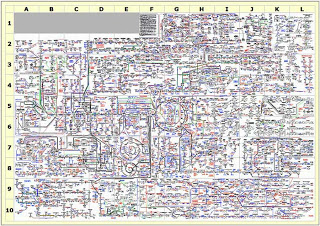 |
This chart represents a portion of the cellular reactions that are taking place every second in a mammalian cell. It looks more like a multicolored plate of pasta, but shows you how complex a single cell is, and remember that this doesn?t even count all the reactions for one cell to be able to talk to another cell. |
The typical mammalian cell contains 2000 or more different proteins as well as many thousands of non-proteins (lipids, carbohydrates, and nucleic acids). Each molecule is crucial for carrying out chemical reactions, and each individual molecule is itself produced, modified, and destroyed by chemical reactions.
When I started to think about all this chemical activity, I looked to see if someone had counted, or at least estimated, the number of reactions taking place in the cell at any one time. I got no answer, not even a reliable guess from a credible source.
Think of it in this light, a plant cell has to perform more than twenty reactions to convert one photon of light into the chemical energy that will later be used for the synthesis of glucose. Each of these twenty reactions is occurring simultaneously at least hundredss of times in every chloroplast of the plant cell, and a single plant cell might have more than one hundred chloroplasts. The numbers add up fast, but remember that production of carbohydrate from light energy is just one of thousands of functions of a plant cell. There are chemical reactions occurring every second for all of these functions.
All this chemistry results in perhaps hundreds of thousands or millions of reactions each second, and all taking place within the confines of a cell that is too small to be seen with the naked eye. Wow!
When talking to students, I often use the analogy that a cell is like a factory, producing many different products at the same time. Not unlike a factory, a cell has to perform many functions, such as energy production, product manufacture, oversight and management, transportation of products, quality checks, and cleanup. What complicates matters is that all these different jobs have to be able to occur simultaneously.
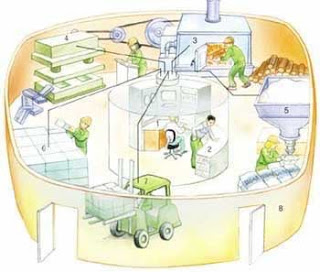 |
I often use the analogy that a cell is like a factory, with different departments. Other like the cell as a city analogy. I even had one student make the analogy that the cell is like a movie set, where the nucleus is the director, and the plasma membrane is the fence around the movie lot, etc. She got an A. |
The business and manufacturing industries stole this strategy from the cell, just as most our good ideas have been copied from nature. The cell uses compartments to increase the efficiency of all its needed chemical reactions. In eukaryotic (eu = true, and karyo= nucleus) cells, the compartments are called organelles (organ = instrument and elle = small), most of which are membrane bound containers.
Remember in our discussion of why cells must be small (It?s All In The Numbers) we said that mixing rate (time needed for a molecule to become evenly dispersed in a cell) and traffic time (time needed for two molecules needed for a certain reaction to find one another) are important for determining the maximum size of a cell.
Membrane bound organelles sequester needed components and create different local environments so that their mixing rates and traffic times are reduced. The result is a cell that is more efficient and can be bigger. This is evidenced by the fact that prokaryotic (pro = before) cells, such as bacteria, don?t have organelles and are about 50 times smaller than eukaryotic cells which have evolved organelles.
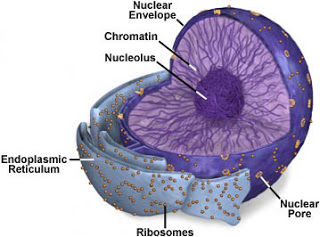 |
The nucleus has two membranes that form an envelope. The outer membrane is continued as the endoplasmic reticulum (ER), another vital cell organelle. The ribosome attached to the ER, so it is easy to see how the organelles work together to make a functioning cell. |
The plasma membrane of the cell also limits the passage of molecules, but the nuclear pores are a complex of many unique proteins and this structure that is nowhere to be seen on the cell?s plasma membrane. Just like the membrane of the cell separates what is in the cell from what is outside the cell, the membrane of the organelle separates the needed components of their reactions from all the unneeded components of the cell.
In addition, many chemical reactions in organelles require the membrane as a workbench. Thousands of reactions take place in or across the membrane. This is an important function of many types of organelles, they increase the membrane surface area of a cell without making it bigger.
Some cellular reactions produce or use an intermediate molecule that must be separated across a membrane in order for the rest of the reaction to take place. This is the case for the mitochondrion ? the energy producer in eukaryotic cells. To produce ATP (adenosine triphosphate, the chemical currency unit of energy in the cell), the mitochondrion sets up a gradient of protons between two membranes (remember that the nucleus has two membranes also) of the mitochondrion. The energy from the leaking of protons back into the inner space is used to produce ATP. We will talk more about these organelles with two membranes in an upcoming post.
Second messenger systems allow for messages from outside the cell to be transmitted throughout the cell. There are three general types, including one for gases like nitric oxide. In all, there are more than two dozen different signal transduction cascades, each with its own set of reactions. |
In some cases, the membrane is not enough compartmentalization. The lysosome is an interesting organelle whose job is to break down many complexes that are brought into a cell and to recycle old organelles so the cell can reuse the parts. To do this, the lysosome contains proteins that can eat up other proteins, lipids, and carbohydrates. Unfortunately, these are the exact same molecules that make up the cell and the lysosomal membrane themselves. So why doesn?t the lysosome digest itself, and the entire cell for that matter?
The protein enzymes in the lysosome work efficiently within a narrow range of acid pH. Therefore, this organelle is acidified when produced. If the lysosome ruptures, the 7.2 pH of the cytoplasm will inactivate the lysosomal acid hydrolases, so the cell is protected. In addition, the lysosome membrane has many sugars stuck to it that act as a buffer between the lipids and proteins of the lysosomal membrane and lysosomal enzymes. There probably is some damage to the lysosome membrane, but repair reactions also help to keep the membrane intact. The cell often has redundant systems for safety.
So, we have seen that many of the organelles function to keep things sequestered in the cell, either for protection, organization, efficiency, or function. However, there are other reasons why organelles are a good idea.
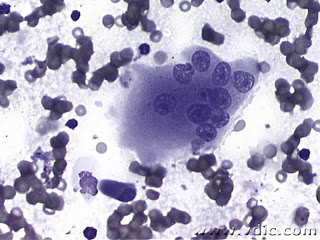 |
Osteoclasts and osteoblasts are hard workers, so much so that they needed more than one set of instructions for their work. The osteoclast above shows multiple nuclei for many DNA copies. Sometimes separate osteoblasts will join together to form a multinucleated giant cell. |
Likewise, osteoclasts (osteo = bone, clast = break) cells break down bone ? and yes, you are breaking down and rebuilding your bones every second of every day. This activity requires many proteins to be produced, and one set of DNA instruction housed in one nucleus is often insufficient for the job. Therefore, these cells often have two or more nuclei in order to get the job done. In these ways, specialization of organelle compartments and combinations allows for specialization of cellular function.
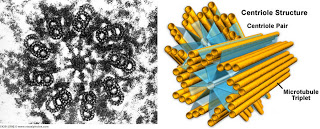 |
Centrioles are organelles important for the cellular division. They are also a target for cancer therapy, since many cancer cells have more than the regular set of two centrioles. |
The take home message is that these organelles, whether membrane bound or not, perform vital services for the cell and make the many cellular reactions possible. The general modus operandi for organelles is that they carry out their functions with in the cell, but one type of organelle is the exception, it?s the traveling organelle.
sciseekclaimtoken-4f69bbdd1d073
For more information on organelles, see:
Organelles ?
http://biology--dev.clc.uc.edu/courses/bio104/cells.htm
http://people.usd.edu/~bgoodman/ReviewFrames.htm
http://library.thinkquest.org/trio/TR0110561/organelles.htm
http://www.cellsalive.com/cells/cell_model.htm
http://utahscience.oremjr.alpine.k12.ut.us/sciber00/7th/cells/sciber/orgtable.htm
http://www.sumanasinc.com/webcontent/animations/content/organelles.html
http://www.youtube.com/watch?v=LP7xAr2FDFU
http://www.biology4kids.com/files/cell_main.html
http://www.vetmed.vt.edu/education/curriculum/vm8054/labs/lab3/lab3.htm
http://www.nobelprize.org/educational/medicine/cell/
http://waynesword.palomar.edu/lmexer1a.htm
http://www.lessonplansinc.com/biology_lesson_plans_cell_organelles.php
http://alex.state.al.us/lesson_view.php?id=23925
http://teachingtoday.glencoe.com/lessonplans/the-cell
http://www.galaxygoo.org/biochem/CellProject/the_cell.html
http://www.etap.org/demo/grade7_science/instruction2tutor.html
http://blog.sciencegeekgirl.com/2010/01/12/hands-on-class-activities-on-the-cell/
http://www.ehow.co.uk/info_8237178_student-activities-cell-organelles.html
http://www.schools.manatee.k12.fl.us/072JOCONNOR/celllessonplans/lesson_plan__cell_structure_and_function.html
http://sciencenetlinks.com/lessons/cells-2-the-cell-as-a-system/
http://classroom.jc-schools.net/sci-units/cells.htm
http://www.teach-nology.com/teachers/lesson_plans/science/biology/cell/
- Animal Eukaryotic Cell Components: Structure And Function
I posted a picture of the eukaryotic animal cell earlier, but it was simply a labeled diagram. Here we will go into each of the major parts of the cell, as well as each organelle's function, not to mention the overall structure of the cell. As the...
- Structure And Functions Of Organelles
The nucleus is bound by two membranes known as the nuclear envelope, which has perforations called nuclear pores. Chromatin within the nucleus condenses to form chromosomes during cell division. The nucleus controls all cellular activity. During mitosis,...
- Eukaryote Vs Prokaryote
Biology EssayMichael McDonald11/17/14Period 7 Cells are categorized into two groups, Prokaryotic and Eukaryotic. The two cells are similar in some ways , but also they are different in others. One way they are similar is that they both have DNA which...
- I'll Karyote On Homeostasis And Organization Further
Cell organization v. homeostasis -cell homeostasis is where there is appropriate internal environment. The plasma membrane forms a cytoplasmic compartment, which maintains homeostasis by allowing cells to exchange materials with their environment. Organelles...
- Prokaryotic Cells Vs. Eukaryotic Cells
Prokaryotic Cells Prokaryote is a cell or an organism that lacks a nucleus and other membrane enclosed organelles and most of their DNA is a single circular molecule. All bacteria are prokaryotic cells. The word "prokaryote" means "before the nucleus"...
